Pink Mold On Pecans: How To Treat Pecan Pink Mold


Pink mold on pecans is a secondary disease that develops when nuts have previously been injured, usually by a fungal disease known as pecan scab. The key to treating pecan pink mold is to address the preliminary problem; pecans with pink mold can usually be avoided if pecan scab fungus is properly controlled. Read on for more information on pecan pink mold.
Symptoms of Pink Mold on Pecans
Initially, pink mold enters through cracks and fissures in the pecans, which exposes damaged tissue within the green hull. If conditions are moist, the pink mold grows rapidly and enters the interior of the pecan, destroying the nut and leaving a mass of pink powder in its place. A rancid odor is often present.
How to Treat Pecan Pink Mold
Management of pecan scab disease usually takes care of any problem with pink mold on pecans. Pecan scab disease is a common but very destructive disease that affects leaves, nuts and twigs, and is especially prominent during wet, humid conditions. You may not be able to completely eliminate the disease, but you can reduce the presence of pathogens, thus minimizing the risk of pecan pink mold. If you’re planting new pecan trees, always start with disease-resistant cultivars. Your local cooperative extension office can provide advice on the best varieties for your area. Plant pecans where the trees receive the best possible air circulation. Allow plenty of space between trees. Similarly, thin and prune the tree properly to maintain healthy airflow. Keep the area clean. Remove debris on the ground around the tree, as leaves, twigs, nuts and other plant matter may harbor disease pathogens. Plowing debris into the soil may help prevent infection. Implement a fungicide spray program. Your local cooperative extension office or a knowledgeable greenhouse or nursery can help you determine the best product for your particular situation. The first spray treatment should be at the pre-pollination stage, as soon as the tree emerges from dormancy in early spring. Reapply fungicide after two and four weeks. At that point, spray every three weeks for the remainder of the growing season. Read the label carefully and use the proper tools for spraying fungicides. Spray the tree thoroughly to create a thin film on all leaf surfaces. Note: Any recommendations pertaining to the use of chemicals are for informational purposes only. Chemical control should only be used as a last resort, as organic approaches are safer and more environmentally friendly. Read more at Gardening Know How: Fruit Tree Spray Schedule: Tips On Proper Fruit Tree Spraying Times https://www.gardeningknowhow.com/edible/fruits/fegen/fruit-tree-spraying.htm
Sign up for the Gardening Know How newsletter today and receive a free copy of our e-book "How to Grow Delicious Tomatoes".

A Credentialed Garden Writer, Mary H. Dyer was with Gardening Know How in the very beginning, publishing articles as early as 2007.